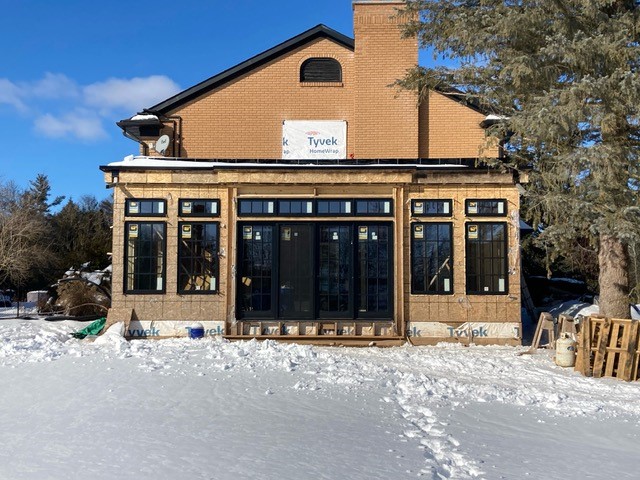The kind of winter we’ll get is a hot topic in southern Ontario. Maybe we’ll get an early ice storm, like in 2013. Perhaps this year, we will barely get a hint of snow until January, like in 2012. Or it could be that Halloween is celebrated under a blanket of snow, like in 2014. Maybe we’ll see random warm 20-degree days in February. Perhaps we’ll say goodbye to the snow in early March, or maybe we’ll still be waiting for it to leave in May.
In southern Ontario, we never know what type of winter we’re going to get or when it will arrive, which is why it’s crucial to be prepared. Your home takes a lot of abuse during the winter to keep your family warm, safe and protected. It only makes sense to ensure it’s in the best shape possible to take whatever Mother Nature decides to throw at it.
Even if you think your home is in good shape and can take on whatever comes its way this winter, home maintenance always serves a variety of purposes. In addition to getting your home ready for winter, taking the time to do these jobs allows you to check over areas that you wouldn’t necessarily notice otherwise. In this way, you can identify minor issues before they become big problems, especially at the most inopportune times.
In this post, we’ll list the most important winterizing jobs around the house and talk about how essential it is to make sure your windows and doors in London and southern Ontario are in the best possible shape to take on whatever kind of winter ends up arriving.

The Role of Windows and Doors
Doors and windows play a key role in keeping your home warm, comfortable and safe throughout the winter. Air leaks are a common cause of discomfort. If you need to bundle up or stay covered under a mountain of blankets just to stay warm, that’s a sign of a problem.
A number of different things can cause drafts. Even brand new windows can leak if they are not installed properly, which is why it is essential that instructions for window installation are followed to the letter and windows are installed by knowledgeable professionals.
When air leaks, or drafts, are bad enough that they are causing a noticeable discomfort in your home, it also means those leaks are affecting your energy bills as well. When the warm air from your home leaks out and cold air leaks in, it means your heating system has to work overtime trying to keep your home at your desired temperature. Windows, doors and skylights can be a significant source of energy loss in your home – up to 35 per cent.
Top Home Winterization Jobs
There are many different jobs and tasks that can be done to winterize your home effectively. These range from helping to keep your home safe and dry to keeping your home warm and comfortable. We’ll focus on both of these, as well as many jobs that serve both purposes.
One of the biggest things to remember when preparing for and dealing with cool weather is that the job starts in the fall. As the leaves start turning and days grow shorter, it’s essential to take the time to go through these jobs, whether you set aside a weekend to get them all done or slowly chip away at them over several weeks and months.
Another thing to keep in mind is that getting these jobs done earlier can put you in a better position should you discover any significant issues that need addressing. If you notice a big problem with your windows, roof, or another area of your home, finding out about it early gives you time to weigh your options and plan your budget accordingly.
Windows and Doors
If your home is drafty, it’s important to identify areas where the leaks are coming from. Check around windows and doors both indoors and outdoors. Other areas to check around include electrical outlets and outdoor faucets. The candle test is an effective way to source where the leak is coming from
- Close all windows and doors and switch off fans
- Get a candle or stick of incense
- Pass candle or incense around doors and windows slowly
- Look for areas where the candle flame flickers, or the smoke stream dances
When you’ve identified the areas, fill gaps with caulk to seal up the leak. You can also reapply weatherstripping if it looks like it is worn down.
Also, be sure to remove screens from windows as they can trap condensation and block the sun. Vacuum, clean, and store them safely until spring.
Furnace
Do a test run early on to make sure your furnace is working properly. Many people forget to do this and inevitably find themselves shivering while struggling to get an appointment with a repairperson when the first cold snap hits.
Homeowners should have annual maintenance done on their furnace by an HVAC professional. Schedule this annual maintenance in the fall to get both done at the same time.
Plumbing
If you have plumbing in a freezing cold basement or crawlspace, it’s important to prepare for temperatures to plummet. Make sure to insulate the pipes to avoid them freezing or bursting, which causes a whole lot of headaches and other problems.
Roof
The roof of your home is a key area to inspect before winter hits. Make sure it is in good condition by giving it a visual inspection for loose, broken, curled or missing shingles. Check your attic and the ceilings in the upper-level rooms for any signs of water damage, which can indicate water leakage. If you notice any issues, call in a professional roofer to have these addressed before they lead to a catastrophic roofing disaster and a full replacement.
Gutters
As the leaves fall in autumn, they can collect on roofs, especially in gutters and downspouts. They can end up blocking the flow of melting snow and ice, leading to icicles and ice dams. To prevent this, clean out your gutters, make sure they are free of debris and double-check that water can flow freely.
Insulation
As we mentioned above, a persistent chill in your home can be caused by air leaks and drafts around your windows and doors. It can also be caused by a lack of insulation. Adding an extra layer of insulation to your attic is an incredibly affordable way to improve your home’s insulation. You’ll feel the results in your comfort level and see it on your energy bills.
Prepare for Snow
An often-overlooked part of winterizing your home is to make sure you have the tools you need to deal with the first frost and snow. Many people forget that their shovel was on its last legs and find themselves dealing with no way to move the first snowfall. For people who prefer a snow blower, make sure you give it a test run. A blizzard isn’t a good time to find out it is not working. Also, be sure to stock up on salt and sand to keep your sidewalks, walkways, and steps safe.
Other Winter Preparation Jobs
There are some preparation jobs that are quick and easy but no less effective. Follow these tips to keep your home warm and cozy throughout the winter:
- Switch your ceiling fans to move clockwise to push hot air towards the floor
- Put draft guards by doors to prevent heat from escaping
- Change the air filter in your furnace
- Add insulated window treatments
- Inspect your fireplace
- Shut off water to exterior faucets
- Clean and store barbecue and patio furniture
These are simple solutions that make a significant difference in your home’s comfort and safety.
Getting New Doors and Windows in Winter
Should you find yourself needing or wanting new doors or windows in the winter, it’s not a problem. Despite popular belief, getting new windows and doors installed in the winter is done all the time and doesn’t have to mean your home gets turned into an icebox. Window and door replacement in the winter is extremely common and is quite similar to installations done in any other season.
One big difference between installing windows during the winter compared to spring, summer, or fall is simply that more flexibility is required for installation. Our certified window installers can handle window and door installations in many different weather conditions, but if there is hard snowfall, severe rain or wind conditions, or temperatures below -20? with the windchill, we’ll need to reschedule. We always make this clear for customers booking installations in the winter months.
The other big differences in winter installations have to do with keeping your house warm and comfortable. Our team of installers understands the need to keep disruptions to a minimum. In winter, our installers will typically work one window at a time and close the door to the room they’re working in to keep the house warm and conserve energy. We also have the ability to erect temporary plastic walls in homes with more open floor plans.
We always make an effort to keep from making a mess in our customer’s homes and bring booties for work boots and drop clothes for floors and carpets to prevent snow, mud and slush from being tracked in.
Other than that, the process is exactly the same as having windows installed in the spring, summer or fall. In fact, despite the extra steps listed above and occasional rescheduling due to weather, many customers find their installation happens much quicker during the winter because it’s the offseason for home renovations. Many homeowners choose to get their new windows installed either when temperatures first drop in the fall, and they begin noticing problems with their windows or in early spring after winter has gone and the renovation season starts booming. By getting your windows in the winter, you can beat the rush and have less of a wait before your installation can be scheduled.
As a windows and doors company serving southern Ontario, we know the importance of staying warm and cozy throughout the long winter months. At Golden Windows, we’ve been manufacturing quality windows for more than 60 years and have seen many winters. We know that our windows and doors have what it takes to protect your home and keep you warm throughout even the coldest Ontario winters.



